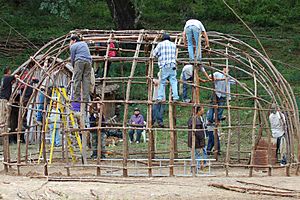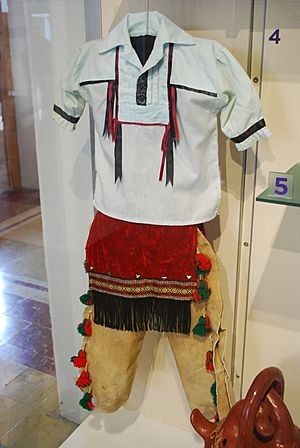Mexican Kickapoo facts for kids

Kikapú building a traditional winter home (wickiup) at El Nacimiento, Coahuila.
|
|
| Total population | |
|---|---|
| 63 (2020) | |
| Regions with significant populations | |
| Languages | |
| Kickapoo, Spanish, English | |
| Religion | |
| traditional tribal religion, Animism Drum religion | |
| Related ethnic groups | |
| other Kickapoo people and Fox, Sauk, and Shawnee people |
The Mexican Kickapoo (Spanish: Tribu Kikapú) are a Native American people. They live in both Mexico and the United States. In Mexico, they were given land in 1850 near the town of Múzquiz in the state of Coahuila. Some smaller groups of Kickapoo also live in Sonora and Durango.
Many Mexican Kickapoo work as migrant workers in Texas. They travel across the Midwest and Western United States. In winter, they return to Mexico. They are connected to the Kickapoo Traditional Tribe of Texas, Kickapoo Tribe of Oklahoma, and Kickapoo Tribe in Kansas. These are tribes officially recognized by the U.S. government.
In 1979, the Mexican Kickapoo who lived in both countries wanted to know their official status. They didn't have clear legal rights in either the United States or Mexico. In 1983, the United States Congress passed a law. This law recognized them as a special group within the Kickapoo Tribe of Oklahoma. It also officially recognized the Kickapoo Traditional Tribe of Texas. A 1985 law gave the Texas group the choice of becoming Mexican or U.S. citizens. About 145 tribal members chose U.S. citizenship. The other 500 or so chose Mexican citizenship.
Contents
Kickapoo Homeland in Mexico
The special land used by the Mexican Kickapoo is about 32 kilometers (20 miles) northeast of Múzquiz. They call it El Nacimiento de la Tribu Kikapú, which means "The Birthplace of the Kickapoo Tribe." Their land covers about 17,300 acres. It is a dry area but has water from the Río Sabinas.
How the Kickapoo Govern Themselves
The Mexican Kickapoo traditionally have a president for their ejido (community lands). This president gets help from a council of elders for business decisions. However, a larger meeting of all the family heads makes all the important tribal political choices. This assembly chooses who will lead the community. The Kickapoo do not have representatives in local, state, or national Mexican politics.
Kickapoo Family Life and Society
The Kickapoo organize their families into clans. In these clans, inheritance and property pass down through the father's side of the family. Children are considered part of their father's clan. Fourteen of the original 17 clans still exist today. These include the Man, Berry, Thunder, Buffalo #1, Tree, Black Bear, Eagle, Brown Bear, Buffalo #2, Fire, Water, Raccoon, and Fox clans. People can marry based on love, but the clan system guides who can marry whom.
The Kickapoo are also matrilocal. This means that when young couples marry, they live in homes near the woman's mother and grandmother. Women are important because they not only take care of the homes, but they also build them. Women gather the materials needed for housing and are in charge of all housework.
Kickapoo Language and Communication
The Mexican Kickapoo speak the Kickapoo language. This language is part of the larger Algonquian languages family. They also speak Spanish and English. They usually learn these languages by hearing them, not in school.
How the Kickapoo Make a Living
The Kickapoo were traditionally hunter-gatherers, meaning they hunted animals and gathered plants for food. In the early 1900s, they started farming. By the 1930s, they had a modern farming system. But severe droughts in the 1940s forced them to stop farming their own land. They became migrant farm workers in the United States. In the 1950s, they changed their farms into grazing lands for raising cattle.
Both men and women work as migrant farm laborers. When they are living in Mexico, only the men are involved in raising and selling livestock.
Kickapoo History and Journeys
Early Beginnings in the North
The name "Kickapoo" comes from their own word Kiwigapawa. This word roughly means "he moves from here to there." The Kickapoo are part of the central Algonquian group. They have close family and language ties with the Sac and Fox people. Europeans first wrote about the Kickapoo around 1667-1670. At that time, they lived where the Fox and Wisconsin Rivers meet. Because of pressure from the Menominee tribe, the Kickapoo and their friends moved south and west. They settled in southern Michigan, Ohio, Illinois, and northern Iowa.
Through several treaties with the U.S. government, starting in 1803, the Kickapoo gave up their lands in the Ohio, Wabash, and Miami River areas. They then moved into Missouri along the Osage River.
Moving to the Plains
In 1832, the Kickapoo gave up their lands in Missouri. They were given a "permanent" home south of the Delaware Nation in Kansas. This was near Fort Leavenworth. Around this time, some Kickapoo went to Texas. The Spanish governor invited them to live there. He wanted them to act as a barrier between Mexico and American settlers. However, the Mexican War of Independence and the Texas Revolution showed that settlers would keep coming. After the Texas Revolution, these Kickapoo groups moved south into Mexico.
In 1854, the tribe gave up the eastern part of their Kansas lands to the United States. This left the Kickapoo with 150,000 acres in the west. Two parts of this treaty had big effects on the tribe. The treaty allowed for a survey of Kickapoo lands. This could be used to divide the land into individual plots. It also gave a railroad the right to build tracks across the reservation.
Local Indian agents and railroad companies wanted the Kickapoo lands to be divided. The Kickapoo had always owned their lands together as a community. It is unlikely they wanted their lands divided. However, officials pushed for this division. This led to a new treaty in 1862. This agreement allowed chiefs to get 320 acres, family heads 160 acres, and other tribe members 40 acres. Most of the remaining 125,000 acres were to be sold to the railroad. Those who didn't want their land divided could keep it together. They could also move to a new reserve in Indian Territory (which is now Oklahoma).
When news of the treaty broke, there were protests. The Kickapoo said they didn't know the agreement had been made. They thought they were still talking about the terms. An investigation followed. Some frustrated Kickapoo decided to leave Kansas. A group of about 700 went to Mexico in September 1864 to join their relatives there. In January 1865, Kickapoo leaders traveled to Mexico City. They wanted to meet with the Mexican government. They sought land rights and protection from attacks by American soldiers and other tribes.
In 1865, pressure from politicians led to the approval of dividing the Kickapoo land. The tribe resisted this. By 1869, only 93 Kansas Kickapoo had accepted individual land plots. The rest preferred to keep their lands together. A small group of about 50 tribesmen returned from Mexico to the Kansas Reservation. They later joined the Kickapoo in Indian Territory in 1874. In 1875, a group of 114 Mexican Kickapoo were returned to the Kansas Reservation.
Settling in Texas and Mexico
The first group of Southern Kickapoo moved around the time the tribe settled in Kansas. They traveled across the Great Plains. They fought the Seminole in Florida around 1837. Then they traveled into Texas looking for horses from the Comanche tribe. In 1850, they agreed to help protect Mexicans and Texas settlers from other tribes like the Lipan and Comanche. As a reward, the Mexican governor gave them land at Hacienda del Nacimiento near Santa Rosa (now Múzquiz). At their strongest, the southern Kickapoo numbered about 1500 people. By 1860, they lived in a wide area from the Canadian and Washita Rivers in Indian Territory to the Sabine and Brazos Rivers in Texas, and to the Remolino River in northern Mexico.
In 1864, about 700 Kickapoo left Kansas. They were upset with the actions of agents and railroad companies. They went to join their relatives in Mexico. On January 8, 1865, Texans attacked the Kickapoo at Dove Creek. The battle was short, and the Texans retreated. The Kickapoo lost about 15 warriors, and the Texans lost twice as many men. In 1868, a report said that about 800 Kickapoo lived in Mexico. It also said they were responsible for raids in western Texas. The U.S. wanted to bring the Kickapoo back to the United States to calm Texas residents and avoid problems with Mexico.
The U.S. Congress passed laws in 1870 and 1871. These laws set aside money to move the Kickapoo from Texas and Mexico to land in Indian Territory. An Indian Agent, John D. Miles, went with Kansas Kickapoo leaders to try to convince the Kickapoo in Santa Rosa to return to the U.S. Mexican officials would not let Miles speak with them. The people of Santa Rosa saw the Kickapoo as their only defense against other raiding tribes.
In 1873, the U.S. tried again to bring the Kickapoo to Indian Territory. Special agents went to Saltillo to talk with the governor. While they were on their way to Santa Rosa, a group of Americans attacked the Kickapoo. They thought the Kickapoo were a raiding group of Lipan. The Kickapoo were not interested in listening to the U.S. agents. In the fall of 1874, the agents finally convinced about 300 Kickapoo to move to Indian Territory.
Moving to Indian Territory (Oklahoma)
The Mexican Kickapoo were to be moved to Indian Territory. This was a place on the north fork of the Canadian River. They were supposed to get farm equipment to start farming for food. This change was hard for them. By 1883, they still didn't have a permanent legal right to the land they were using. On August 15, 1883, an executive order gave the Kickapoo the lands they had been using. This land was near the southwest corner of the Sac and Fox Reservation.
Four years later, a law called the Dawes Act put pressure on tribes to divide their shared lands into individual plots. On June 21, 1891, the Kickapoo agreed to give up their reservation. In return, each tribal member would get an 80-acre plot. The Kickapoo strongly opposed this division of land. They fought against it until 1894. They were right to resist, as it caused them to lose large amounts of their land.
Images for kids




